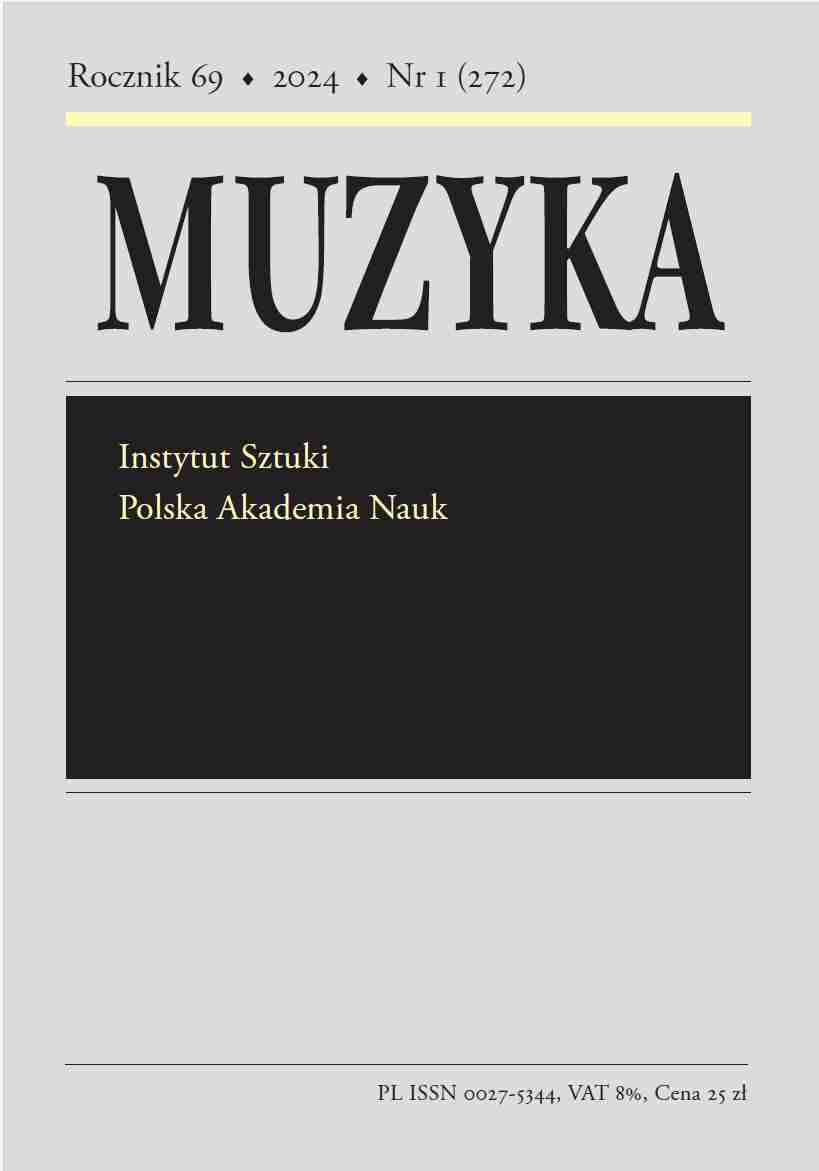Niccolò Paganini’s 'Caprices' as Interpreted by Henryk Wieniawski
Abstract
Niccolò Paganini’s 'Caprices', one of the most demanding cycles in the violin repertoire, continue to pose a challenge for many violinists, as they did in the year of their publication, 1820. These 24 miniature showpieces had little to do with the original educational character of the genre. On the contrary, they were a virtuosic display of the skills of their composer, who would remain unrivalled to this day.
Though Paganini’s 'Caprices' did not occupy a major place in Henryk Wieniawski’s concert repertoire, they were well known to him. Extremely valuable in this respect is the copy of the Caprices now held in the library of the Conservatoire Royal de Musique in Brussels, which bears traces of use by the Polish violinist. I take this copy of the Caprices as the starting point for analysis of the sources of his early fascination with Paganini’s performance style. I briefly discuss Wieniawski’s education in Joseph Lambert Massart’s class at the Paris Conservatoire, his interest in Apolinary Kątski’s manner of playing and his stay with Karol Lipiński in Dresden. I also address the role of Paganini’s 'Caprices' in Wieniawski’s work as a teacher at the St Petersburg and Brussels conservatories. At the centre of my article is a presentation of the Brussels copy of the Caprices, in terms of both the history of the source and the scope of Wieniawski’s interference in the original musical material of the edition. This analysis sheds valuable light on Wieniawski’s performance style, rarely considered in the subject literature.
Keywords:
Henryk Wieniawski, Niccolò Paganini, violin playing, nineteenth centuryReferences
Borer, Philippe. „The Twenty-Four Caprices of Niccolo Paganini. Their Significance for the History of Violin Playing and the Music of the Romantic Era”. Dysertacja doktorska, University of Tasmania, 1995.
Google Scholar
Fetis, Francois Joseph. Biographie universelle des musiciens et bibliographie générale de la Musique. T. 5. Bruxelles: Meline, Cans et Compagnie, 1839.
Google Scholar
Grigoriew, Władimir. Henryk Wieniawski. Życie i twórczość. Przekł. Iwona Winiarska. Warszawa–Poznań: PWN, 1986.
Google Scholar
Illiano, Roberto. „Paganini: A Virtuoso Composer”. W: Henryk Wieniawski and the Bravura Tradition, red. Maciej Jabłoński, Danuta Jasińska, 149–157. Poznań: Towarzystwo Muzyczne im. H. Wieniawskiego, PTPN, 2011.
Google Scholar
Méthode du Violon par MM. Baillot, Rode, et Kreutzer, Membres du Conservatoire de Musique. Redigée par Baillot. Adoptée par le Conservatoire pour servir a l’Étude dans cet Établissement, Paris: Faubourg, [ok. 1793].
Google Scholar
Paganini, Niccolo. 24 Capricci Per Violino solo Composti e Dedicati agli Artisti. Milano: Ricordi [ok. 1820].
Google Scholar
Paganini, Niccolo. Vingt-quatre Caprices ou Études pour le Violon. Paris: Richault [ok. 1824].
Google Scholar
Stowell, Robin. „Henryk Wieniawski: ≪the true successor≫ of Nicolò Paganini? A Comparative Assessment of the Two Virtuosos with Particular Reference to Their Caprices”. W: Spielpraxis der Saiteninstrumente in der Romantik. Bericht des Symposiums in Bern, 18.–19. November 2006, red. Claudio Bacciagaluppi, Roman Brotbeck, Anselm Gerhard. T. 3, 70–90. Schliengen: Edition Argus, 2011.
Google Scholar
Suchowiejko, Renata. Henryk Wieniawski – wirtuoz w świetle XIX-wiecznej prasy. Poznań: Towarzystwo Muzyczne im. H. Wieniawskiego, 2011.
Google Scholar
Wąsowski, Marcin. „Virtuosity in Caprices by Karol Lipiński and Niccolo Paganini”. W: Henryk Wieniawski and the 19th Century Violin Schools, red. Maciej Jabłoński, Danuta Jasińska, 89–102. Poznań: Towarzystwo Muzyczne im. H. Wieniawskiego, 2006.
Google Scholar
Statistics
Abstract views: 701PDF downloads: 401
License
Copyright (c) 2020 Ewa Chamczyk

This work is licensed under a Creative Commons Attribution-NonCommercial-NoDerivatives 4.0 International License.
The author grants the publisher a royalty-free nonexclusive licence (CC BY 4.0) to use the article in Muzyka, retains full copyright, and agrees to identify the work as first having been published in "Muzyka" should it be published or used again (download licence agreement). By submitting an article the author agrees to make it available under CC BY 4.0 license.
Articles from 2018/1 to 2022/3 were published under a Creative Commons license CC BY-NC-ND 4.0. During this period the authors granted the publisher a royalty-free nonexclusive license (CC BY-ND 4.0) to use their article in "Muzyka", retained full copyright, and agreed to identify the work as first having been published in our journal should it be published or used again.
Most read articles by the same author(s)
- Ewa Chamczyk, Concerning Apolinary Kątski’s date of birth – new sources , Muzyka: Vol. 64 No. 1 (2019)
- Ewa Chamczyk, Conquering Europe’s musical hub: Apolinary Kątski’s Parisian decade (1838–1848) , Muzyka: Vol. 63 No. 4 (2018)
- Wiktoria Antonczyk, Ewa Chamczyk, Apolinary Kątski’s St Petersburg File as a Source for the Study of the Violinist’s Biography , Muzyka: Vol. 66 No. 2 (2021)










